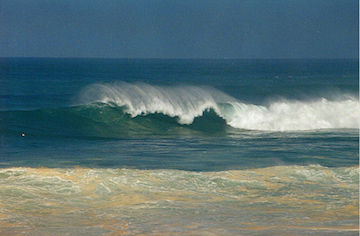390416-making waves.jpg

Waves that routinely break on shore are generated by winds. Credit: National Oceanic and Atmospheric Administration
When a wave breaks gently on the shore, it may be completing a journey of many days and hundreds or thousands of miles. Yet the water that comes ashore has journeyed no more than a few feet and a few seconds. That’s because a wave transmits only energy, not water.
To visualize how that works, think about two people holding opposite ends of a long rope. One person snaps her end of the rope, creating a wave. The wave moves along the full length of the rope, perhaps jiggling the hand of the person on the other end. But when the wave is through, the rope is right where it started.
The waves that routinely break on shore are generated by winds. The moving air produces friction that moves molecules of water at the surface, creating small ripples. As the wave passes, water in the wave moves in a circle — up, forward, down, and back to where it started. That keeps the wave moving, but leaves the water in place.
The first ripples give the wind more surface to push against, which builds higher and longer waves. The waves may travel at tens of miles per hour, and reach heights of many feet. Sometimes, bands of waves intersect. They combine their energy, building monster waves more than a hundred feet high. These “rogue” waves can sink ships in a matter of minutes.
Waves get especially big in tropical storms and hurricanes. Pushed by strong winds, they get stronger as they move ashore. They create a “storm surge” that can roll miles inland, destroying everything in its path — the relentless power of a wave.

